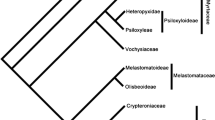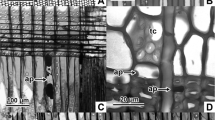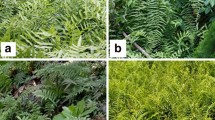Abstract
The distribution of scalariform and simple perforation plates along vessels in Arthrophyllum otopyrenum, Meryta tenuifolia, and Polyscias multijuga (Araliaceae) is examined. In all three species, most vessels bear simple perforation plates only, but the combination of simple and scalariform perforation plates in variable ratios also occurs. Aggregated arrangement of scalariform perforation plates along the vessels was statistically confirmed in some vessel portions. The scalariform perforation plates occur mostly in narrow vessels that are grouped in multiples. Within the clade represented by Polyscias and Arthrophyllum, the evolutionary transition from scalariform to simple perforation plates is realized as the gradual elimination of vessels or vessel portions with scalariform perforation plates, but is not accompanied by a gradual decrease of the number of bars per perforation plate. The narrow vessels that are grouped in vessel multiples are likely to retain the ability to develop scalariform plates, which could promote the evolution from simple to scalariform perforation plates as is the case within Meryta.








Similar content being viewed by others
References
Alldridge NA (1964) Anomalous vessel elements in wilty-dwarf tomato. Bot Gaz 125:138–142
Aloni R, Feigenbaum P, Kalev N, Rosovsky S (2000) Hormonal control of vascular differentiation in plants: the physiological basis of cambium ontogeny and xylem evolution. In: Savidge R, Barnett J, Napier R (eds) Cell and molecular biology of wood formation. BIOS Scientific Publishers, Oxford, pp 223–236
André J-P (1993) Micromoulage des espaces vides intra- et intercellulaire dans les tissues végétaux. C R Acad Sci Paris 316:1336–1341
André J-P (1998) A study of the vascular organization of the bamboos (Poaceae, Bambuseae) using a microcasting method. IAWA J 19:265–278
André J-P (2005) Vascular organization of angiosperms. A new vision. Science Publishers, Enfield
Baas P (1976) Some functional and adaptive aspects of vessel member morphology. In: Baas P, Bolton AJ, Catling DM (eds) Wood structure in biological and technological research. Leiden Bot. Series no. 3. Leiden University Press, The Hague, pp 157–181
Baas P, Wheeler EA (1996) Parallelism and reversibility in xylem evolution: a review. IAWA J 17:351–364
Baas P, Ewers FW, Davis SD, Wheeler EA (2004) Evolution of xylem physiology. In: Hemsley AR, Poole I (eds) The evolution of plant physiology. Elsevier, Amsterdam, pp 273–295
Bailey IW (1944) The development of vessels in angiosperms and its significance in morphological research. Am J Bot 31:421–428
Bannan MW (1958) An occurrence of perforated tracheids in Thuja occidentalis L. New Phytol 57:132–134
Butterfield BC, Philipson WR, Meylan BA, Ohtani J (1984) Comparative morphology of vessel elements in the woods of Pseudopanax C. Koch (Araliaceae). N Z J Bot 22:509–514
Carlquist S (2001) Comparative wood anatomy. Systematic, ecological, and evolutionary aspects of dicotyledon wood, 2nd edn. Springer, Berlin
Chaffey NJ, Barnett JR, Barlow PW (1999) A cytoskeletal basis for wood formation in angiosperm trees: the involvement of cortical microtubules. Planta 208:19–30
Dickison WC (1975) The bases of angiosperm phylogeny: vegetative anatomy. Ann Mo Bot Gard 62:590–620
Dickison WC (1989) Steps toward the natural system of dicotyledons: vegetative anatomy. Aliso 12:555–566
Dickison WC (2000) Integrative plant anatomy. Academic Press, San Diego
Ellerby DJ, Ennos AR (1998) Resistances to fluid flow of model xylem vessels with simple and scalariform perforation plates. J Exp Bot 49:979–985
Frost FH (1930) Specialisation in secondary xylem of dicotyledons. II. Evolution of end wall of vessel segment. Bot Gaz 90:198–212
Hacke UG, Sperry JS (2001) Functional and ecological xylem anatomy. Perspect Plant Ecol Evol Syst 4:97–115
Herendeen PS, Wheeler EA, Baas P (1999) Angiosperm wood evolution and the potential contribution of paleontological data. Bot Rev 65:278–300
Jane FW (1956) Perforated vertical tracheids in Sequoia sempervirens Endl. New Phytol 55:367–368
Jansen S, Baas P, Gasson P, Lens F, Smets E (2004) Variation in xylem structure from tropics to tundra: evidence from vestured pits. Proc Natl Acad Sci USA 101:8833–8837
Lowry PP II, Plunkett GM, Wen J (2004) Generic relationships in Araliaceae: looking into the crystal ball. S Afr J Bot 70:382–392
Meylan BA, Butterfield BG (1975) Occurrence of simple, multiple, and combination plates in the vessels of New Zealand woods. N Z J Bot 13:1–18
Nakashima J, Takabe K, Fujita M, Fukuda H (2000) Autolysis during in vitro tracheary element differentiation: formation and location of the perforation. Plant Cell Physiol 41:1267–1271
Noshiro S, Baas P (1998) Systematic wood anatomy of Cornaceae and allies. IAWA J 19:43–97
Oda Y, Hasezawa S (2006) Cytoskeletal organization during xylem cell differentiation. J Plant Res 119:177–187
Ohtani J (1984) SEM observations on perforation plates in some Rubiaceae. In: Proceedings of the first Pacific regional wood anatomy conference, Tsukuba, pp 61–63
Oskolski AA (1996) A survey of the wood anatomy of the Araliaceae. In: Donaldson LA, Singh AP, Butterfield BG, Whitehouse LJ (eds) Recent advances in wood anatomy. New Zealand Forest Research Institute, Rotorua, pp 99–119
Oskolski AA, Lowry PP II (2001) Wood anatomy of Schefflera and related taxa (Araliaceae). II. Systematic wood anatomy of New Caledonian Schefflera. IAWA J 22:301–330
Oskolski AA, Kotina EL, Fomichev IV, Tronchet F, Lowry PP II (2007) Systematic implications of wood and bark anatomy in the Pacific Island genus Meryta (Araliaceae). Bot J Linn Soc 153:363–379
Plunkett GM, Lowry PP II, Vu NV (2004a) Phylogenetic relationships among Polyscias (Araliaceae) and close relatives from the western Indian Ocean basin. Int J Plant Sci 165(5):861–873
Plunkett GM, Wen J, Lowry PP II (2004b) Infrafamilial relationships in Araliaceae: insights from nuclear (ITS) and plastid (trnL-trnF) sequence data. Plant Syst Evol 245:1–39
Rick CM (1952) The grafting relations of wilty dwarf, a new tomato mutant. Am Nat 86(828):173–184
Rodriguez RL (1957) Systematic anatomical studies on Myrrhidendron and other woody Umbellales. University of California Publications in Botany, vol 29, pp 145–318
Sano Y, Okamura Y, Utsumi Y (2005) Visualizing water-conduction pathways of living trees: selection of dyes and tissue preparation methods. Tree Physiol 25:269–276
Schulte PJ (1999) Water flow through a 20-pore perforation plate in vessels of Liquidambar styraciflua. J Exp Bot 5:1179–1187
Schulte PJ, Castle AL (1993) Water flow through vessel perforation plates—the effects of plate angle and thickness for Liriodendron tulipifera. J Exp Bot 44:1143–1148
Schulte PJ, Gibson AC, Nobel PS (1989) Water flow in vessels with simple or compound perforation plates. Ann Bot 64:171–178
Smith AC (1985) Order Araliales. In: Smith AC (ed) Flora vitiensis nova, a new flora of Fiji, vol 3. Pacific Tropical Botanical Garden, Lawai, Kauai, Hawai’i, pp 631–660
Sperry JS (2003) Evolution of water transport and xylem structure. Int J Plant Sci 164(3 suppl):S115–S127
Stern WL (1978) A retrospective view of comparative anatomy, phylogeny, and plant taxonomy. IAWA Bull 2:33–39
Takhtajan A (1991) Evolutionary trends in flowering plants. Columbia University Press, New York
Terentev PV (1964) Use of the iteration method for quantitative investigations of animal populations. Use of mathematical methods in biology, issue 3. Leningrad State University, Leningrad, pp 105–110 (in Russian)
Tronchet F, Plunkett GM, Jérémie J, Lowry PP II (2005) Monophyly and major clades of Meryta (Araliaceae). Syst Bot 30:657–670
Uggla C, Moritz T, Sandberg G, Sundberg B (1996) Auxin as a positional signal in pattern formation in plants. Proc Natl Acad Sci USA 93:9282–9286
Viguier R (1910–1913 (1925)) Contribution à l’étude de la flore de la Nouvelle-Calédonie—Araliacées. J Bot (Morot), II(3):38–87
Wheeler EA (1995) Wood of Platanus kerrii. IAWA J 16:127–132
Wheeler EA, Baas P (1991) A survey of the fossil record for dicotyledonous wood and its significance for evolutionary and ecological wood anatomy. IAWA Bull 12:271–332
Wheeler EA, Baas P (1993) The potentials and limitations of dicotyledonous wood anatomy for climatic reconstructions. Paleobiology 19:486–497
Ye ZH (2002) Vascular tissue differentiation and pattern formation in plants. Ann Rev Plant Biol 53:183–202
Zimmermann MH (1983) Xylem structure and the ascent of sap. Springer, Berlin
Acknowledgments
Research conducted by the first author was supported by an International Incoming Short Visit from the Royal Society (2006/R1) and from the Russian Foundation of Basic Research (RFFI, no. 06-04-48003a). Financial support to SJ was provided by a NERC grant (NE/E001122/1). We acknowledge Pete Lowry (Missouri Botanical Garden, St Louis, and Muséum National d’Histoire Naturelle, Paris) for obtaining the wood samples, Natalia S. Rostova (St Petersburg State University) and Vladislav I. Vasilevich (Komarov Botanical Institute, St Petersburg) for their valuable consultations on statistical methods, and Annelies Pletsers (Jodrell Laboratory) for assistance with applying the resin casting technique, and anonymous reviewers for their useful comments to this paper.
Author information
Authors and Affiliations
Corresponding author
Rights and permissions
About this article
Cite this article
Oskolski, A.A., Jansen, S. Distribution of scalariform and simple perforation plates within the vessel network in secondary xylem of Araliaceae and its implications for wood evolution. Plant Syst Evol 278, 43–51 (2009). https://doi.org/10.1007/s00606-008-0130-z
Received:
Accepted:
Published:
Issue Date:
DOI: https://doi.org/10.1007/s00606-008-0130-z




